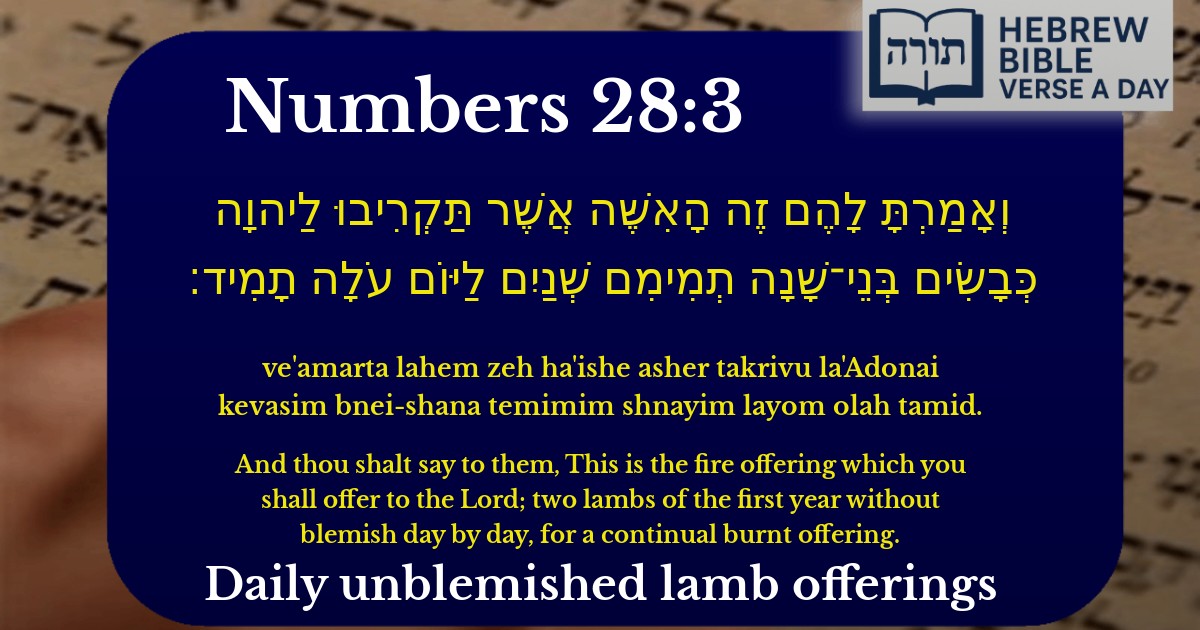Join Our Newsletter To Be Informed When New Videos Are Posted
Join the thousands of fellow Studends who rely on our videos to learn how to read the bible in Hebrew for free!
Hebrew Text
וְאָמַרְתָּ לָהֶם זֶה הָאִשֶּׁה אֲשֶׁר תַּקְרִיבוּ לַיהוָה כְּבָשִׂים בְּנֵי־שָׁנָה תְמִימִם שְׁנַיִם לַיּוֹם עֹלָה תָמִיד׃
English Translation
And thou shalt say to them, This is the fire offering which you shall offer to the Lord; two lambs of the first year without blemish day by day, for a continual burnt offering.
Transliteration
Ve'amarta lahem zeh ha'ishe asher takrivu la'Adonai kevasim bnei-shana temimim shnayim layom olah tamid.
Hebrew Leining Text
וְאָמַרְתָּ֣ לָהֶ֔ם זֶ֚ה הָֽאִשֶּׁ֔ה אֲשֶׁ֥ר תַּקְרִ֖יבוּ לַיהֹוָ֑ה כְּבָשִׂ֨ים בְּנֵֽי־שָׁנָ֧ה תְמִימִ֛ם שְׁנַ֥יִם לַיּ֖וֹם עֹלָ֥ה תָמִֽיד׃
Parasha Commentary
📚 Talmud Citations
This verse is quoted in the Talmud.
📖 Menachot 49b
The verse is discussed in the context of the daily burnt offerings and the requirements for the lambs to be without blemish.
📖 Yoma 33a
The verse is referenced in a discussion about the order of the daily sacrifices and the importance of the continual burnt offering.


The Daily Tamid Offering
The verse (Bamidbar 28:3) commands the daily offering of two unblemished lambs, known as the Korban Tamid, which were brought twice daily—once in the morning and once in the afternoon. Rashi explains that the term Tamid ("continual") emphasizes the perpetual nature of this mitzvah, which applies even on Shabbat and Yom Tov (with additional offerings). The Rambam (Hilchot Temidin u'Musafin 1:1-3) elaborates that this offering symbolizes the Jewish people's unwavering devotion to Hashem, as it is constant and unchanging.
Symbolism of the Lambs
The requirement for kevasim bnei shanah ("lambs of the first year") teaches that the offering must be young and pure, free from any physical defects. The Midrash (Bamidbar Rabbah 21:21) connects this to the idea of renewal—just as the lambs are in their first year, so too should our service to Hashem be fresh and sincere each day. The Shulchan Aruch (Orach Chayim 1:1) further links this to the concept of hishtadlut (effort), as one must actively seek spiritual renewal daily.
Two Lambs: Morning and Afternoon
The Fire Offering (Ishsheh)
The term ishsheh ("fire offering") underscores that the korban is wholly consumed by the fire of the Mizbe’ach, symbolizing total submission to Hashem’s will (Malbim). The Sforno adds that this reflects the ideal of mesirut nefesh (self-sacrifice), as the flames ascend upward, mirroring the soul’s yearning for closeness to the Divine.
Contemporary Lessons
Although the Beit HaMikdash is not standing today, the Chofetz Chaim (in Mishna Berura 1:9) teaches that the times of the Tamid correspond to the fixed times for Shacharit and Mincha prayers. Thus, the verse reminds us to structure our days around avodat Hashem, ensuring consistency in our spiritual growth.